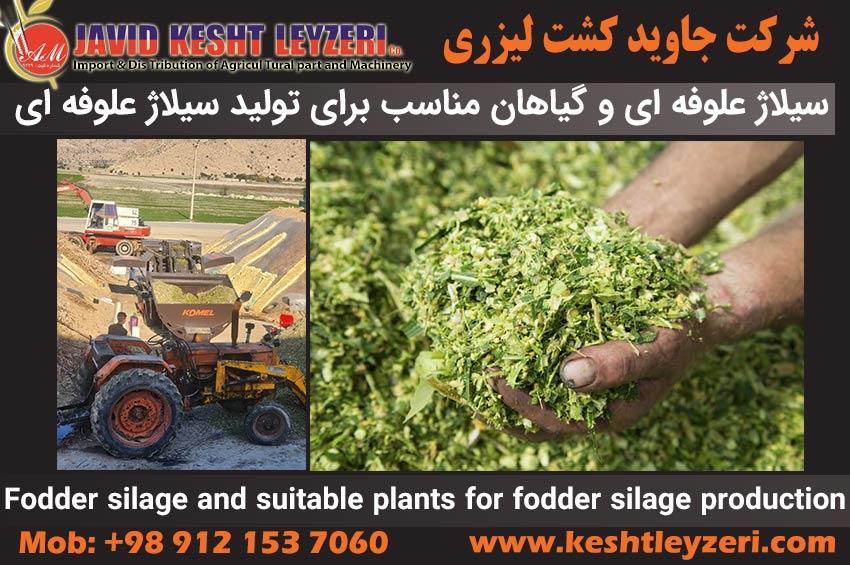
Fodder silage and suitable plants for fodder silage production
javid keshtleyzeri Co.ltd
Definition of forage silage
Fodder silage is a product resulting from the fermentation process of anaerobic (producing) lactic acid bacteria on compressed products from fodder plants, edible plants, vegetable waste, waste from food factories (in pure form and mixed together) with the aim of preserving and increasing Nutritive value and creating sustainability in Nasi, juicy fodder is produced throughout the year.
The production and preparation of fodder silage is not only limited to the use of corn plants and a large number of edible forage and non-fodder plants such as khasil, oats, terticale, turnips, alfalfa and clover in pure and mixed forms and even stubble plant residues (grains and Waste of food factories, molasses, beet pulp, beet pulp, tomato pulp, production waste (chips) mixed with plants or plant waste can be turned into fodder silage.
Advantages of forage silage
. Using a stable combination of feed called silage for a long period of time, especially during dry periods. Maintaining the quantity and quality of vitamins and minerals in fodder at a higher level than dry fodder and almost equal to fresh fodder. Harmful nitrates in plants such as corn, sorghum and winter cereals, which are accumulated during the period of drought stress or more fertilization during the process Anaerobic fermentation of silage production is eliminated or reduced to the minimum possible amount. Favorable use of by-products such as winter cereal crops, vegetable waste, waste of food factories, etc. Silage can be a very suitable alternative for feeding livestock in times of lack of fodder and seasons. dry year
Silage better protects the fodder against the harmful effects of the sun, insects, fire and fungus.
Suitable plants and compounds for fodder silage production
Fodder corn with early, medium and late ripening groups has been used as the main source of silage production in the country for many years, but due to the serious water restrictions in the country, other sources should be considered for silage production. . . Winter grains include triticale barley, oats (oats) and rye, which we call these plants fodder grains and have enough plant sugars for proper and complete fermentation to produce silage, and if they are combined with leguminous plants such as vetiver, cowpea, etc. .. if they are cultivated as a mixture, they will have enough protein. . There are also leguminous plants that are grown in areas with low rainfall and prone to drought, such as alfalfa, sorghum, alfalfa, cowpea, etc., which have high protein content, but their sugar content is insufficient for proper fermentation and good silage production. Therefore, if they are ensiled in a mixture with cereals or summer grasses such as sweet sorghum, they create a good quality of fodder silage.
New varieties of sorghum, such as Pegah variety or varieties with high sugar, as a plant resistant to drought and unusually salty waters, can be stable and reliable sources for silage production in the coming years. Plant wastes such as stubble of winter grains, wastes from sugar factories such as pomace and beet molasses or sugarcane, wastes from tomato paste factories, waste from apple chips factories, ground waste from fruit juice factories in a mixed form), by adjusting the amount of sugar and excess Lactic acid producing bacteria can be a nutritious yet inexpensive source for silage production. An application program for the production of fodder silage. Choose fodder crops including barley or oats (oats) to provide the right ratio of carbon hydrates, and vetiver or kholer to provide the protein ratio to produce high-quality silage.
The very important feature of these plants is their digestibility and high crude protein and palatability of their silage. In addition to these one-year grains, due to their features such as ease and cheap seed planting, having many species and varieties with high adaptability in different environmental conditions, it is possible to cultivate them in autumn and harvest green fodder in late winter and early spring. . In the fall, you do a mixed crop of barley or oat with sorghum or sorghum with a seed ratio of 120 kg of oats plus 50 kg of sorghum or sorghum per hectare, and only two stages of irrigation in the fall season and probably one The stage in early spring seems to be sufficient until the time of harvest. . Do the harvesting operation using a solar chopper and in the soft dough stage of barley or oat grains and immediately ensile them. Finally, after about 3 to 4 months, a nutritious silage with a protein and energy ratio even higher than corn silage is available to livestock. It will be your milk and meat.
Fodder silage is a method of preserving plant fodder that converts food into silage using the process of microbial fermentation, bacteria and fungi. This method is used to preserve precious fodder and provide proper nutrition for livestock.
Plants suitable for producing fodder silage generally include wheat, barley, corn, sugar beet, sunflower, etc. These species are suitable for silage production for the following reasons:
1. Feed content: These species have significant amounts of protein, carbohydrates and other nutrients that are necessary for the growth and nutrition of livestock.
2. Accessible: These species are easily available and can be grown in large scale.
3. Fermentation ability: these species have good fermentation ability and absorb the necessary microbes for the silage process well.
4. Resistance to diseases: These species are generally resistant to plant diseases and pests that reduce the yield of vegetables used in silage.
5. High yield: These species have high fodder yield and can be cultivated and produced economically.
In general, these species are suitable for the production of fodder silage, but the points of accuracy during harvesting and subsequent activities such as crushing, compaction and fermentation must also be taken into account during the forage harvest to ensure that they are at the optimal stage of fodder production. Most of the nutrient content and nutritional value of plants are active in the growth phase. Therefore, fodder should be harvested at the right time and prevent the loss of quality and nutritional value.
After harvesting, forages should be chopped to increase the contact surface with microbes and fungi. Crushing forages increases the contact surface with yeasts and bacteria and improves fermentation activity.
Then, the chopped fodder should be pressed regularly to reduce its volume. Pressing the fodder removes excess air and provides a suitable environment for the growth of microbes.
Finally, the compressed forage must be fermented under suitable conditions. This includes maintaining the right humidity, the right temperature, and using the right yeasts and bacteria. Proper fermentation of fodder breaks down their decomposable parts and produces lactic acid, which preserves fodder in the form of silage.
Therefore, in the next silage activities, you should be careful and use the correct methods for crushing, compaction and fermentation. These activities are carried out independently or by using a threshing machine or crushing and compacting machines. It is necessary to compact the fodder after crushing to reduce their volume and provide a suitable space for the growth of microbes. For this purpose, it is possible to use compacting devices such as trolleys or stackers. Finally, the compressed forage must be fermented under suitable conditions. This includes maintaining the right humidity, the right temperature and using the right yeasts and bacteria. Correct fermentation of fodder causes decomposition of their decomposable parts and production of lactic acid, which preserves fodder in the form of silage.






